Free SRSD Teacher Materials
Welcome educators! Ready to supercharge your writing lessons? These fantastic resources, compliments of SRSD creator Dr. Karen Harris, perfectly supplement our world-class, evidence-based SRSD online course. Or they can be used all by themselves! From step-by-step guides to engaging activities and handy printables, we have everything you need to enhance your teaching toolkit. Dive in, explore, and watch your students' writing skills soar! Thanks, Karen, and happy teaching!
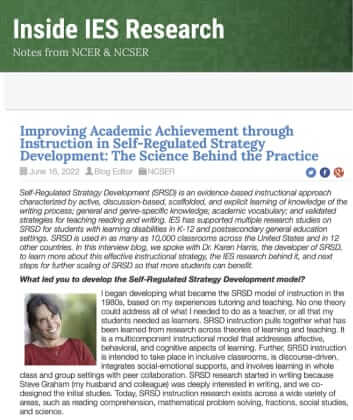
Improving Academic Achievement through Instruction in Self-Regulated Strategy Development: The Science Behind the Practice
Inside IES Research, June 16, 2022
Self-Regulated Strategy Development (SRSD) is an evidence-based instructional approach characterized by active, discussion-based, scaffolded, and explicit learning of knowledge of the writing process; general and genre-specific knowledge; academic vocabulary; and validated...
Self-Regulated Strategy Development (SRSD) is an evidence-based instructional approach characterized by active, discussion-based, scaffolded, and explicit learning of knowledge of the writing process; general and genre-specific knowledge; academic vocabulary; and validated strategies for teaching reading and writing. IES has supported multiple research studies on SRSD for students with learning disabilities in K-12 and postsecondary general education settings. SRSD is used in as many as 10,000 classrooms across the United States and in 12 other countries. In this interview blog, we spoke with Dr. Karen Harris, the developer of SRSD, to learn more about this effective instructional strategy, the IES research behind it, and next steps for further scaling of SRSD so that more students can benefit.
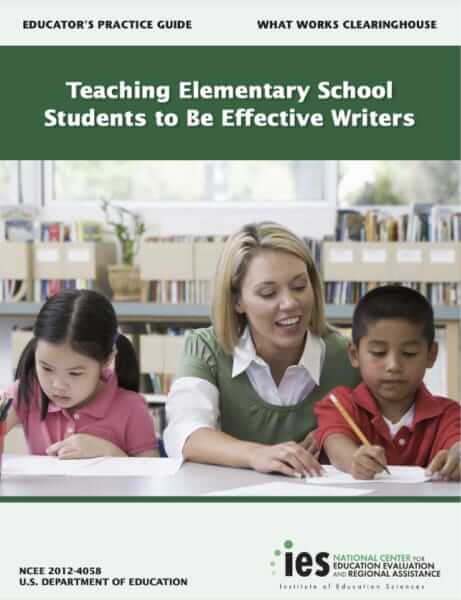
IES Practice Guide: Teaching Elementary School Students to Be Effective Writers
Steve Graham et al. (2012)
When downloading the “Educator’s Practice Guide: What Works Clearinghouse – Teaching Secondary Students to Write Effectively,” you receive a detailed and structured resource designed to tackle classroom and school challenges...
When downloading the “Educator’s Practice Guide: What Works Clearinghouse – Teaching Secondary Students to Write Effectively,” you receive a detailed and structured resource designed to tackle classroom and school challenges in teaching writing. The guide starts with an introduction that sets the context for the recommendations. The first recommendation focuses on explicitly teaching appropriate writing strategies using a Model-Practice-Reflect instructional cycle. This is further broken down into teaching strategies explicitly and utilizing the instructional cycle to reinforce them. The second recommendation emphasizes integrating writing and reading to highlight key writing features. The third recommendation advises using assessments of student writing to inform instruction and provide feedback. Additional sections include a glossary, a postscript from the Institute of Education Sciences, information about the authors, disclosure of potential conflicts of interest, and a rationale for evidence ratings. The guide concludes with comprehensive references and endnotes, ensuring I have a robust framework to effectively enhance my students’ writing skills.
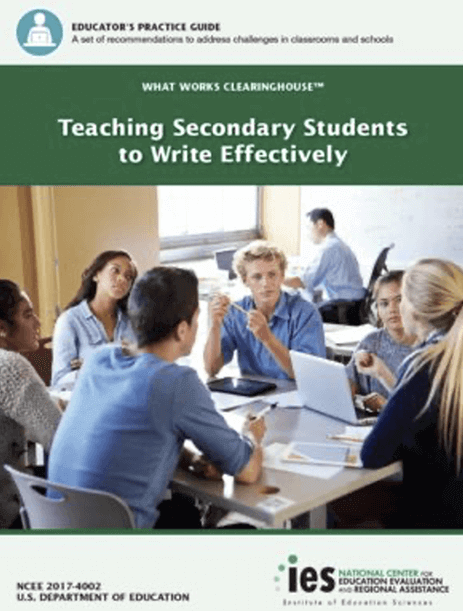
Teaching Secondary Students to Write Effectively
Steve Graham et al. (2012)
When downloading the “Educator’s Practice Guide: What Works Clearinghouse – Teaching Secondary Students to Write Effectively,” You will receive a detailed and structured resource designed to tackle classroom and school...
When downloading the “Educator’s Practice Guide: What Works Clearinghouse – Teaching Secondary Students to Write Effectively,” You will receive a detailed and structured resource designed to tackle classroom and school challenges in teaching writing. The guide starts with an introduction that sets the context for the recommendations. The first recommendation focuses on explicitly teaching appropriate writing strategies using a Model-Practice-Reflect instructional cycle. This is further broken down into teaching strategies explicitly and utilizing the instructional cycle to reinforce them. The second recommendation emphasizes integrating writing and reading to highlight key writing features. The third recommendation advises using assessments of student writing to inform instruction and provide feedback. Additional sections include a glossary, a postscript from the Institute of Education Sciences, information about the authors, disclosure of potential conflicts of interest, and a rationale for evidence ratings. The guide concludes with comprehensive references and endnotes, ensuring you have a robust framework to effectively enhance your students’ writing skills for teaching writing to secondary school students. It includes detailed, step-by-step instructions on implementing these strategies in the classroom, real-world examples, and tips for overcoming common challenges. The guide also provides a wealth of supplementary materials, such as lesson plans, writing prompts, and assessment tools to help teachers effectively foster their students’ writing skills. Additionally, it includes insights into creating a positive writing environment and encouraging student engagement and motivation in writing activities.
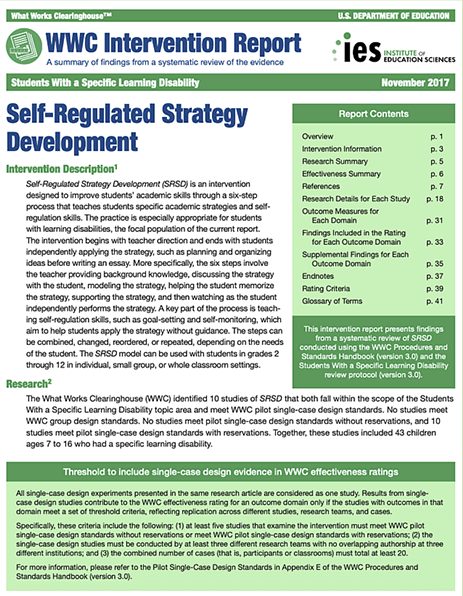
What Works Clearinghouse Intervention Report: Self-Regulated Strategy Development
Steve Graham, Karen Harris et al. (2017)
When downloading the “Self-Regulated Strategy Development (SRSD) Intervention Report,” you will access a detailed guide on an effective teaching method designed to improve students’ academic skills. This report outlines a...
When downloading the “Self-Regulated Strategy Development (SRSD) Intervention Report,” you will access a detailed guide on an effective teaching method designed to improve students’ academic skills. This report outlines a six-step process that starts with teacher-led instruction and progresses to students independently applying strategies such as planning and organizing their ideas before writing. The six steps include providing background knowledge, discussing, modeling, memorizing, supporting, and independently performing the strategy. Additionally, the report emphasizes teaching self-regulation skills like goal-setting and self-monitoring. The SRSD model is adaptable, allowing steps to be combined, reordered, or repeated based on student needs, and can be used with students in grades 2 through 12 in various settings. The report also includes a comprehensive research summary showing SRSD’s positive effects on writing achievement. It provides an overview of the intervention, research details, outcome measures, and effectiveness ratings, making it a valuable resource for improving writing instruction in diverse educational environments.
Here is a table from the What Works Clearinghouse report:
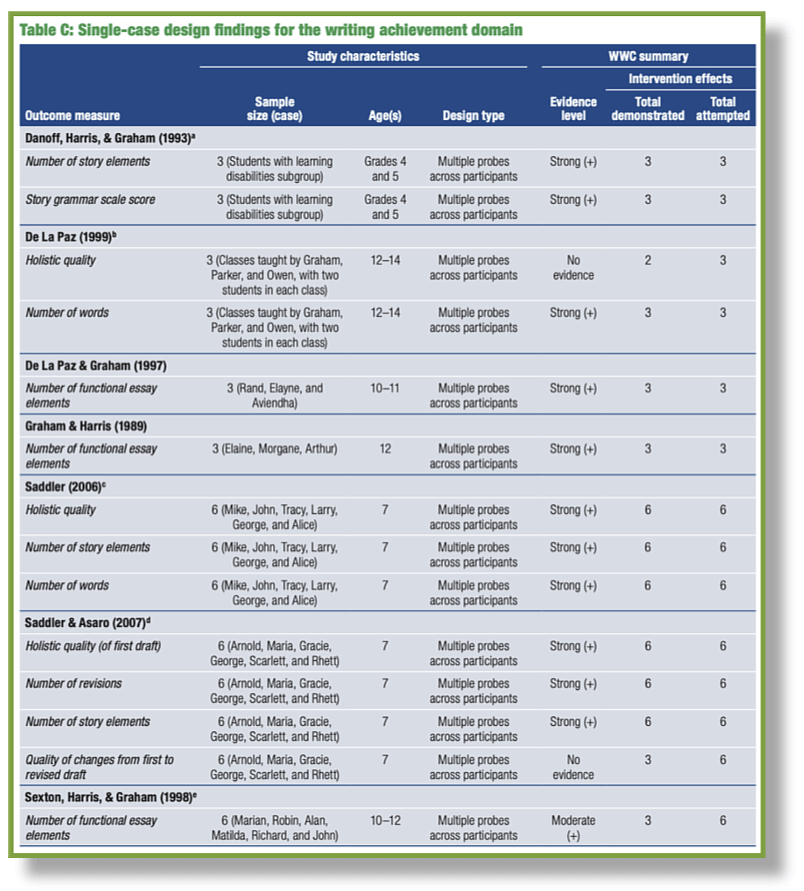
This chart presents findings from various single-case design studies on the effectiveness of Self-Regulated Strategy Development (SRSD) in improving writing achievement for students with learning disabilities. In summary, SRSD is an effective intervention for improving various aspects of writing for students with learning disabilities. Multiple studies show strong positive effects, indicating that SRSD is a robust and broadly applicable approach. It positively impacts a wide range of writing skills, from story structure to overall quality and length of texts. The consistent positive outcomes across different age groups and settings reinforce the reliability and validity of SRSD as an effective instructional method. The chart strongly supports these conclusions, demonstrating the consistent and significant benefits of SRSD for enhancing writing achievement.
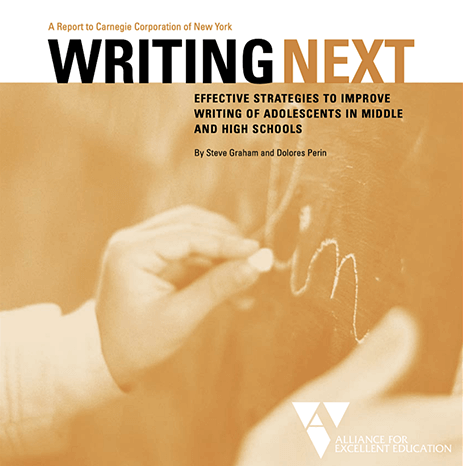
Writing Next: Effective Strategies to Improve Writing of Adolescents
Graham & Perin (2007)
When downloading the study “Writing Next: Effective Strategies to Improve Writing of Adolescents in Middle and High Schools” by Steve Graham and Dolores Perin, you receive a comprehensive report that...
When downloading the study “Writing Next: Effective Strategies to Improve Writing of Adolescents in Middle and High Schools” by Steve Graham and Dolores Perin, you receive a comprehensive report that enhances writing instruction for adolescents through empirical evidence-based recommendations. Commissioned by the Carnegie Corporation, this influential report synthesizes research to identify 11 key elements of effective writing instruction using a meta-analysis of experimental and quasi-experimental studies. These elements include writing strategies, summarization, collaborative writing, specific product goals, word processing, sentence-combining, prewriting, inquiry activities, the process writing approach, the study of models, and writing for content learning. The guide provides an executive summary, detailed implementation recommendations, and appendices detailing the meta-analysis methodology and supporting studies. It highlights the need for all students, especially struggling writers, to become proficient and flexible writers, stimulating policy and research discussions to improve literacy nationwide.
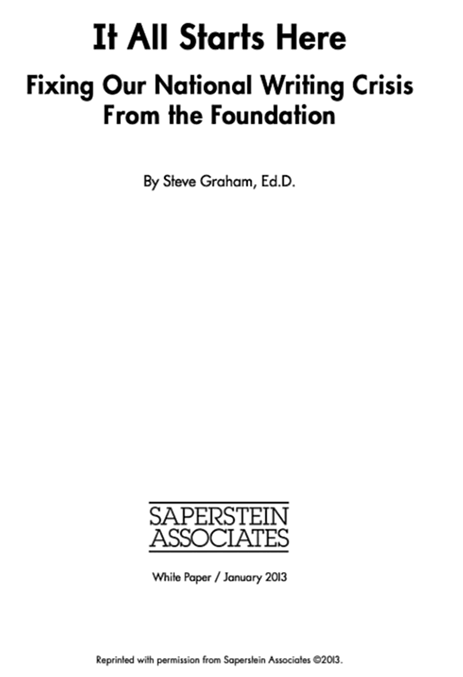
It All Starts Here: Fixing our National Writing Crisis From the Foundation
Steve Graham (2015)
Teachers will find specific strategies for effective writing instruction, such as providing ample writing practice, using frequent assessments to inform instruction, explicitly teaching writing...
Teachers will find specific strategies for effective writing instruction, such as providing ample writing practice, using frequent assessments to inform instruction, explicitly teaching writing processes and strategies, and integrating writing across the curriculum. This resource aims to equip educators with the knowledge and tools to address and resolve the national writing crisis by strengthening writing instruction at all grade levels.
This white paper, “It All Starts Here: Fixing Our National Writing Crisis from the Foundation” by Steve Graham, Ed.D., is an in-depth analysis of the state of writing education in the United States and practical recommendations for improvement. This document addresses the alarming decline in writing proficiency among students, as evidenced by low SAT and NAEP scores. It emphasizes the critical need for foundational writing skills from early grades to ensure students are prepared for the demands of higher education and the modern workforce. This white paper includes detailed discussions on the importance of writing, the impact of writing on academic success, and the evolving requirements of the 21st-century workplace. The white paper underscores the importance of a positive writing environment and the role of technology in writing instruction.
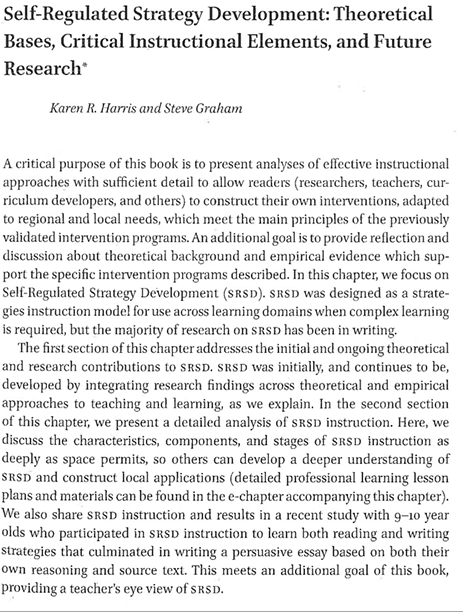
Self-Regulated Strategy Development: Theoretical Bases, Critical Instructional Elements, and Future Research
Karen Harris and Steve Graham (2018)
By downloading this study, you’ll gain a comprehensive understanding of Self-Regulated Strategy Development (SRSD) for persuasive writing using informational text. This resource will provide a step-by-step guide on implementing SRSD...
By downloading this study, you’ll gain a comprehensive understanding of Self-Regulated Strategy Development (SRSD) for persuasive writing using informational text. This resource will provide a step-by-step guide on implementing SRSD in your classroom, backed by a robust evidence base from over 100 studies. You’ll learn about the theoretical foundations of SRSD, how it has evolved since the 1980s, and why it is effective. The book also addresses common misconceptions and highlights future research needs. This practical resource will equip you with strategies to enhance your students’ writing skills through scaffolded, explicit instruction and criterion-based learning.
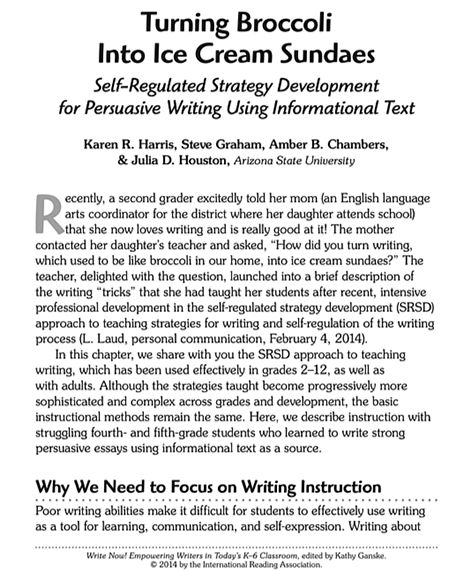
Turning Broccoli Into Ice Cream Sundaes: Self-Regulated Strategy Development for Persuasive Writing Using Informational Text
Harris, Graham, Chambers & Houston (2014)
By downloading this study, Turning Broccoli into Ice Cream Sundaes (Harris, Graham, Chambers, Houston), you will discover how to transform the challenging task of teaching persuasive writing into an engaging...
By downloading this study, Turning Broccoli into Ice Cream Sundaes (Harris, Graham, Chambers, Houston), you will discover how to transform the challenging task of teaching persuasive writing into an engaging and successful experience for your students. This study investigates the Self-Regulated Strategy Development (SRSD) approach, which integrates close reading of informational text with persuasive writing instruction. The study conducted with 4th and 5th-grade students from a diverse, low-income school demonstrates how SRSD can help struggling writers significantly improve their writing skills. Teachers will find detailed strategies, practical examples, and insights into implementing SRSD effectively to enhance their students’ writing abilities, making the process enjoyable and fruitful for both teachers and students.
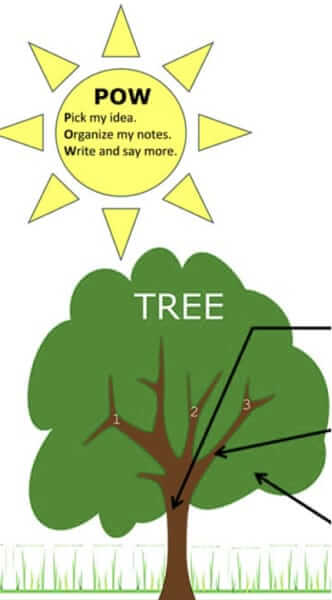
POW + TREE + TWA for Writing Persuasively from Source Text: Lesson Plans, Materials, and Tips
Karen Harris and Steve Graham (2017)
This downloadable document provides lesson plans that supplement “Design Principles for Teaching Effective Writing,” which covers the theoretical foundations, key instructional elements, and future research directions of SRSD. Teachers will...
This downloadable document provides lesson plans that supplement “Design Principles for Teaching Effective Writing,” which covers the theoretical foundations, key instructional elements, and future research directions of SRSD. Teachers will find detailed descriptions of SRSD instruction for the strategies POW + TREE + TWA, which are designed to enhance students’ opinions and persuasive writing skills using source texts. The materials, developed with the assistance of SRSD researchers Amber Ray and Julia Houston from Arizona State University, offer practical applications for teaching writing strategies. Additionally, these lesson plans build upon previous works, including “Powerful Writing Strategies for All Students” by Harris, Graham, Mason, and Friedlander (2008) and “Building Comprehension in Adolescents” by Mason, Reid, and Hagaman (2012). You can find both books under our “Recommended Resources” tab.
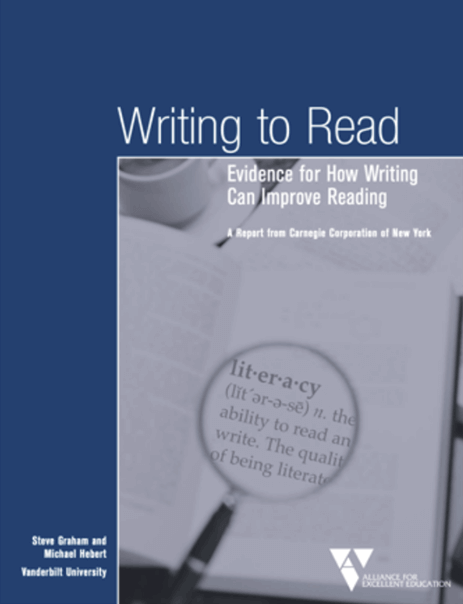
Writing to Read: Evidence for How Writing Can Improve Reading
Steve Graham and Michael Hebert (2010)
Over the past decade, numerous efforts, including studies like “Reading Next” (Biancarosa and Snow, 2004) and reviews by Scammacca et al. (2007) and Graham and Perin (2007a), have aimed to...
Over the past decade, numerous efforts, including studies like “Reading Next” (Biancarosa and Snow, 2004) and reviews by Scammacca et al. (2007) and Graham and Perin (2007a), have aimed to improve adolescent literacy skills. Writing, often overlooked, can enhance reading comprehension by helping students record, analyze, and connect ideas. The report “Writing to Read: Evidence for How Writing Can Improve Reading” by Steve Graham and Michael Hebert, published by the Alliance for Excellent Education and funded by the Carnegie Corporation of New York, explores the significant but often underappreciated relationship between writing and reading. The report identifies three core instructional practices that effectively boost reading skills through writing and emphasizes integrating writing into the reading curriculum to enhance learning and comprehension. It builds on the foundation laid by the earlier “Time to Act” reports, aiming to advance adolescent literacy for college and career readiness. This resource provides an executive summary, an introduction, evidence-based recommendations from a meta-analysis, and detailed strategies for classroom implementation. Additionally, it offers a future research agenda, thorough references, and appendices detailing the meta-analysis methodology and supporting studies. “Writing to Read” calls for more attention from researchers and policymakers on writing instruction as a crucial element of educational programs, advocating for a holistic approach to literacy that acknowledges the interconnectivity of reading and writing. By downloading this report, teachers receive practical, research-backed strategies to effectively integrate writing and reading instruction.
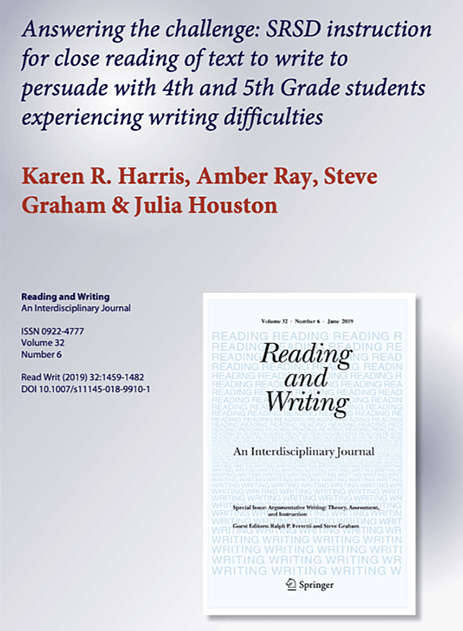
Answering the Challenge: SRSD Instruction for Close Reading of Text to Write to Persuade with 4th and 5th Grade Students Experiencing Difficulties
Harris, Ray, Graham & Houston (2019)
By downloading this study, teachers will gain access to an innovative set of instructional procedures designed to teach 4th and 5th grade students how to write persuasive essays based on...
By downloading this study, teachers will gain access to an innovative set of instructional procedures designed to teach 4th and 5th grade students how to write persuasive essays based on close reading of source texts. This research involved eight students from a diverse, low-income school and utilized the Self-Regulated Strategy Development (SRSD) approach, integrating discussion, modeling, explicit instruction, scaffolding, and collaboration. The study measured improvements in genre elements, holistic quality, word count, and writing plan complexity, showing significant gains in writing outcomes. Teachers will find detailed strategies for teaching persuasive writing, insights on how to support students with writing difficulties, and practical examples of how SRSD can be effectively implemented to enhance student writing skills in a classroom setting.
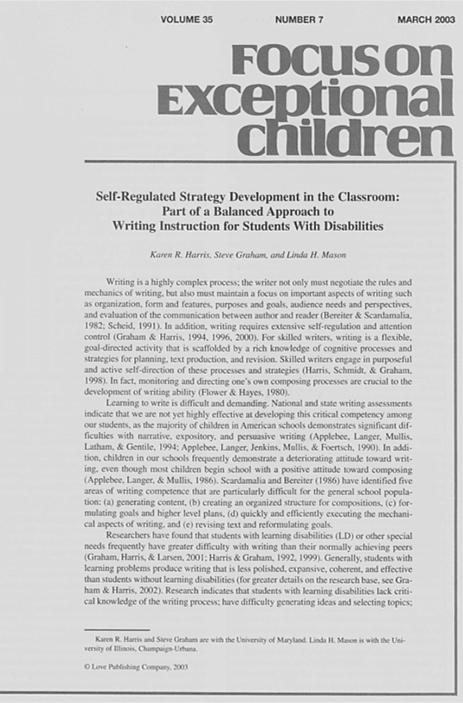
Self-Regulated Strategy Development in the Classroom: Part of a Balanced Approach to Writing Instruction for Students with Disabilities
Harris, Graham & Mason (2003)
When downloading the “Self-Regulated Strategy Development (SRSD) in the Classroom: Part of a Balanced Approach to Writing Instruction for Students with Disabilities” report by Harris, Graham, and Mason, you will...
When downloading the “Self-Regulated Strategy Development (SRSD) in the Classroom: Part of a Balanced Approach to Writing Instruction for Students with Disabilities” report by Harris, Graham, and Mason, you will receive a comprehensive guide on using the SRSD intervention to enhance academic skills, particularly for students with learning disabilities. The document details a six-step process that transitions from teacher-led instruction to student independence, providing background knowledge, discussing, modeling, memorizing, supporting, and independently applying the strategy. It emphasizes self-regulation skills like goal-setting and self-monitoring, adaptable steps based on student needs, and applicability for grades 2 to 12. Included are practical implementation guidance, research summaries, and effectiveness assessments, particularly highlighting SRSD’s positive impact on writing achievement. It is a valuable resource for improving student writing and self-regulation skills.
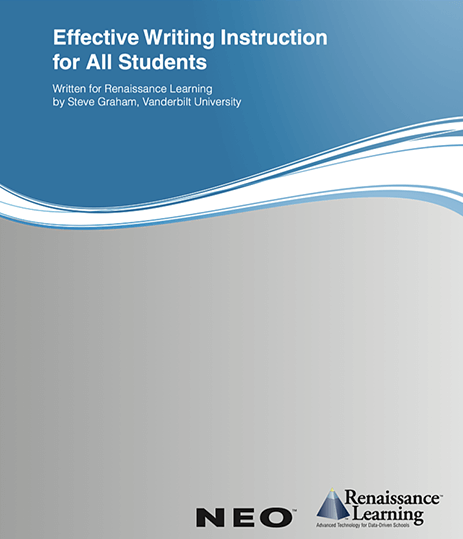
Effective Writing Instruction for All Students
Steve Graham (2008)
When you download “Effective Writing Instruction for All Students” by Steve Graham, you receive a comprehensive guide designed to enhance writing instruction across grade levels. Written for Renaissance Learning, this...
When you download “Effective Writing Instruction for All Students” by Steve Graham, you receive a comprehensive guide designed to enhance writing instruction across grade levels. Written for Renaissance Learning, this publication offers seven evidence-based recommendations to improve students’ writing skills. These include dedicating time to writing across the curriculum, increasing students’ knowledge about writing, fostering their interest and motivation, helping them become strategic writers, teaching basic writing skills to mastery, leveraging technological tools, and using assessments to gauge progress and needs. The guide is grounded in scientific studies and practical teaching strategies, providing teachers with actionable steps to implement effective writing practices in their classrooms. It also emphasizes the importance of consistent and sustained writing instruction to ensure students become proficient writers from early grades through high school. By downloading this report, teachers gain valuable insights and tools to support all students, including those with learning difficulties, ultimately enhancing their academic performance and literacy skills.
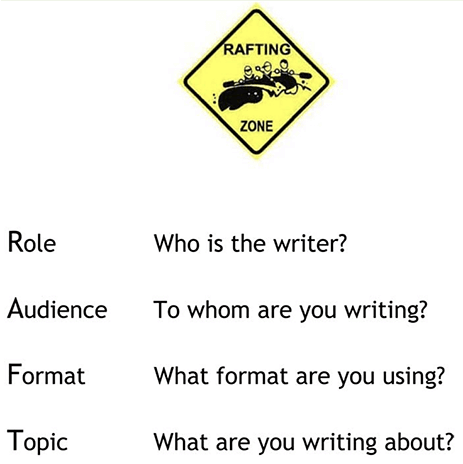
SRSD for RAFT Writing: Role, Audience, Format, Topic
Linda Mason and Paul Haspel (2018)
When downloading this e-book chapter on SRSD instruction for RAFT writing, you will gain access to a comprehensive set of instructional materials designed to enhance their teaching practice. The lessons...
When downloading this e-book chapter on SRSD instruction for RAFT writing, you will gain access to a comprehensive set of instructional materials designed to enhance their teaching practice. The lessons illustrate the six stages of SRSD instruction (develop prior knowledge, discuss it, model it, memorize it, support it, and independent practice), emphasizing the importance of self-regulation strategies throughout. The e-book includes detailed lesson plans for four sessions, mnemonic charts, planning sheets, and self-statement sheets to support student learning. Additionally, you will find sample RAFT prompts, anchor RAFTs for literature, social studies, and science, and a handout providing tips for developing a persona. This resource equips educators with the tools to effectively teach RAFT writing, assess students’ abilities, and tailor instruction to meet individual needs.
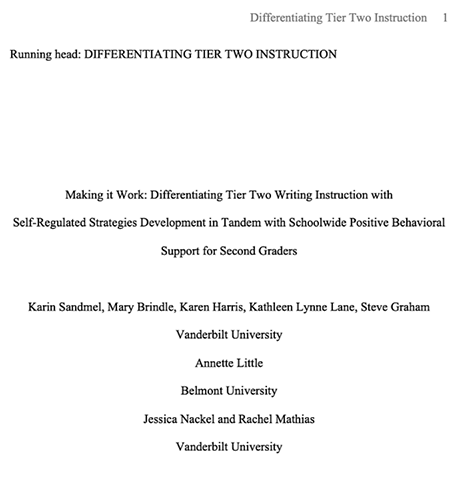
Making it work: Differentiating Tier Two Self-Regulated Strategies Development in Writing in Tandem with Schoolwide Positive Behavioral Support for Second Graders
Sandmel, Harris, Brindle & Lane (2009)
By downloading the study “Making it Work: Differentiating Tier Two Writing Instruction with Self-Regulated Strategy Development in Tandem with Schoolwide Positive Behavioral Support for Second Graders,” you will receive a...
By downloading the study “Making it Work: Differentiating Tier Two Writing Instruction with Self-Regulated Strategy Development in Tandem with Schoolwide Positive Behavioral Support for Second Graders,” you will receive a comprehensive guide on enhancing writing instruction for second graders, particularly those with learning disabilities and behavioral challenges. This study explores the integration of Self-Regulated Strategy Development (SRSD) with Positive Behavioral Support (PBS), showcasing how these approaches can be adapted to meet the diverse needs of students. Teachers will learn about the six stages of SRSD instruction, practical strategies for differentiation, and real-life examples of how these methods have been successfully implemented to improve student writing outcomes. The report includes detailed case studies, modifications for individual learning styles, and insights on creating an inclusive and effective writing program within a schoolwide PBS framework.
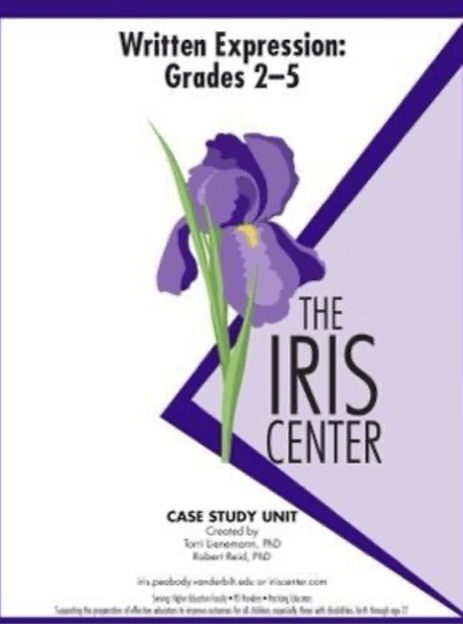
Written Expression Grades 2-5
Torri Lienemann and Robert Reid (2009)
When you download the IRIS case study “Written Expression: Grades 2-5” by Torri Lienemann and Robert Reid, you receive a valuable resource designed to...
When you download the IRIS case study “Written Expression: Grades 2-5” by Torri Lienemann and Robert Reid, you receive a valuable resource designed to address the writing challenges elementary and middle school students face. The study covers lower-level skills like handwriting, spelling, and grammar and higher-level skills such as idea formulation, planning, organizing, and revising text. It engages students in active learning and self-regulation through the Self-Regulated Strategy Development (SRSD) model. Specific strategies include POW + WWW, What=2, How=2 for narratives, and POW + TREE for persuasive essays, helping students systematically plan and organize their writing. The study demonstrates notable improvements in the quality and organization of students’ writing, with increased narrative elements and clearer argumentative structures in persuasive essays. Additionally, the guide provides STAR sheets with planning and organizing strategies for narratives and persuasive essays, revising strategies, and multiple case studies to illustrate practical application. This comprehensive resource equips educators with practical tools and interventions to support struggling writers, ultimately enhancing their academic performance and literacy skills.






